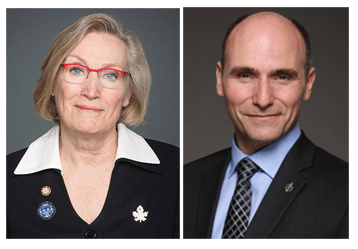In advance of the beginning of Canada’s 44th parliament, Physicians for a Smoke-Free Canada (PSC) has written the new Minister and Associate Minister of Health to recommend priority actions to reduce tobacco use. The letter can be read here.
The health charity urges the ministers to address two key weaknesses in the federal approach to tobacco control: a) the commercialization of tobacco harm reduction and b) the absence of a plan to phase out the supply and demand for tobacco and nicotine.
PSC’s president, Dr. Atul Kapur noted that tobacco industry products continue to be responsible for more deaths in Canada than any other preventable risk. “Because previous ministers of health decided to delay putting adequate regulatory controls on the tobacco industry, more than 50,000 Canadians died from tobacco use this year — greatly more than deaths from COVID-19 and opioids combined.”
Dr. Kapur noted that while past and current efforts to reduce smoking have had good effect, they have failed to prevent the continued epidemic of tobacco in Canada. “Decades after the federal government acknowledged the harms of smoking, there are no laws to forbid tobacco companies from recruiting new users. One-third of Canadians who smoke today — over 1 million younger adults — began doing so in this century, after core measures like graphic health warnings, higher taxes and smoke-free places were in effect.”
PSC notes that other health agencies and researchers have recently identified deficiencies in Health Canada’s tobacco strategy, calling it “incremental, erratic and reactive” and having “no coherent plan to reduce tobacco use … no milestones, benchmarks or tangible national plans beyond optimistic guidance documents.” [1]
In its letter, PSC asks Ministers Duclos and Bennett to engage outside experts, civil society and in the preparation of the review they are obliged by law to provide to Parliament by next spring, and identifies its own priorities for reform. These are:
- Preventing future addiction by adopting the policy goal of ending commercial nicotine and tobacco use.
- Aligning the supply of tobacco with public health goals by reforming retail distribution, removing commercial incentives for suppliers to recruit new users and requiring manufacturers to meet public health targets, possibly through the use of production caps or other supply controls now used in environmental regulation.
- Expanding current demand-reduction measures by fully implementing and scaling up the measures required by the Framework Convention on Tobacco Control, improving the delivery of supports to vulnerable populations, and developing new and innovative demand-reduction approaches.
“This government has committed to ending the sale of combustion engines in passenger cars by 2035 – but remarkably has no plan in sight to end the same of combustible cigarettes.” PSC’s president, Dr. Atul Kapur pointed out. “The ‘way’ to end the tobacco pandemic is there – what is needed is the ‘will’ of ministers of health to make it happen.”
Priority measures to reduce addiction and disease caused by commercial tobacco and nicotine products
1. PREVENT FUTURE ADDICTION
Commit to end the harms from commercial tobacco and nicotine.
The federal government should adopt as a policy goal the end of commercial nicotine and tobacco use, [as Finland has done](https://www.finlex.fi/en/laki/kaannokset/2016/en20160549_20161374.pdf). In coordination with other levels of government and civil society, Health Canada should establish a timeframe with specific interim and long-term targets to ensure that new generations are not recruited to commercial tobacco or nicotine use.
2. REFORM TOBACCO SUPPLY
Align the supply of commercial tobacco and nicotine with public health goals.
Currently tobacco and nicotine manufacturers, retailers and other suppliers are motivated and rewarded to maximize economic returns, with many of their business practices guided by economic pressure and corporate law. Key reforms needed are:
- De-commercialization of harm reduction.
- Reforming retail distribution and ensuring that tobacco and nicotine products are not sold outside of adult-only specialty stores or by individuals trained and motivated to support cessation.
- Requiring tobacco companies to contribute to winding down tobacco use and nicotine addiction, for example by obliging them to meet public health targets for production and consumption. Examples of mechanisms that can assist this are found in the federal Climate Action Plan.
3. EXPAND EFFECTIVE EXISTING MEASURES
Maximize the potential for demand-reduction measures
There is an international consensus around a set of demand-side interventions that are embraced by the Framework Convention on Tobacco Control. Canada’s implementation of these measures has not yet optimized their impact. Canada should intensify, scale up or develop innovative approaches to measures such as the following:
- End all promotions for consumer (non-therapeutic) tobacco and nicotine products, including those delivered in bars, through social media or direct-mail, and ban incentive programs and other promotions directed at retailers.
- Eliminate flavourings in all consumer (non-therapeutic) tobacco and non-tobacco flavourings from nicotine products products,
- Regulate the market introduction of new tobacco/nicotine products by establishing notification and authorization processes.
- Raise the legal minimum age to 21 and phase in a smoke-free generation policy.
- Apply equally stringent regulations to non-therapeutic nicotine products and tobacco.
- Enhance programming and develop tailored approaches for more vulnerable communities.
- Increase tobacco prices substantially through tax increases and price regulation (preferably standardized pricing).
- Accelerate regulation-making and remove structural barriers to timely policy-implementation for tobacco control.
- Provide international leadership (including financial support for global efforts).
- Apply the polluter-pay principle, recovering the cost of related Canadian public health interventions from the tobacco and nicotine industries











